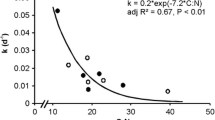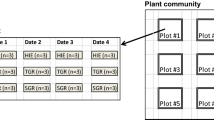Abstract
The highly invasive giant knotweed (Reynoutria spp.) often displaces nettle (Urtica dioica) dominated stands in European floodplains. Urtica-dominated stands differ from the monospecific Reynoutria stands in plant species richness and stand structure. We thus hypothesize that Reynoutria invasion profoundly alters ecosystem structure and function, with negative effects cascading up through the food chain. We performed a paired sampling design in six sites belonging to two different locations and studied effects on the soil and the litter-dwelling fauna. Reynoutria stands differed in habitat structure and were characterized by decreased soil pH and potassium depletion. The faunal analysis is based on model groups of herbivore generalists (Gastropoda), detritivores (Isopoda and Diplopoda), and predators (Opiliones). The gastropod assemblages from Reynoutria stands were severely impoverished subsets of those from Urtica stands with reduced densities, species richness and diversity. In general, snails were more sensitive to Reynoutria invasion than slugs such as the invasive Arion 'lusitanicus’. Among detritivores, the abundance of the Isopoda decreased, whereas Diplopoda were not affected by Reynoutria invasion. Yet, the relative abundance of detritivores was significantly higher within the Reynoutria stands. Abundance, species richness and diversity of the predatory Opiliones were higher in the relatively sparse Reynoutria stands. We conclude that ecosystem changes associated with Reynoutria invasion are characterized by shifts from a plant-based to a detritus-based food chain and that Reynoutria invasion primarily enhances predators that profit from the simplified vegetation structure.



Similar content being viewed by others
REFERENCES
Beaulieu F, Wheeler TA. (2002) Insects (Diptera, Coleoptera, Lepidoptera) reared from wetland monocots (Cyperaceae, Poaceae, Typhaceae) in southern Quebec. Proc Entomol Soc Wash 104:300–8
Beerling DJ, Dawah HA. (1993) Abundance and diversity of invertebrates associated with Fallopia japonica (Houtt. Ronse Decrane) and Impatiens glandulifera (Royle): two alien plant species in the British Isles Entomologist 112:127–39
Beerling DJ, Bailey JP, Conolly AP. (1994) Fallopia japonica (Houtt.) Ronse Decraene. J Ecol 82:959–79
Boag DA. (1990) On the effectiveness of artificial shelters in the study of population attributes of small terrestrial gastropods. Can J Zool 63:1089–95
Child W, Wade M. (2000) The Japanese knotweed manual. The management and control of an invasive alien weed. Chichester: Packard Publishing
Colwell RK. (2005) EstimateS: statistical estimation of species richness and shared species from samples. Version 7.5. Persistent URL: http://www.purl.oclc.org/estimates
Crooks JA. (2002) Characterizing ecosystem-level consequences of biological invasions: the role of ecosystem engineers. Oikos 97:153–66
Ehrenfeld JG. (2003) Effects of exotic plant invasions on soil nutrient cycling processes. Ecosystems 6:503–23
Frest TJ, Sanders Rhodes R. (1982) Oxychilus draparnaldi in Iowa. Nautilus 96:36–49
Frömmig E. (1954) Biologie der mitteleuropäischen Landgastropoden. Berlin: Duncker and Humblot. p 404
Grimm B, Schaumberger K. (2002) Daily activity of the pest slug Arion lusitanicus under laboratory conditions. Ann Appl Biol 141:35–44
GärdenforsU, Waldén HW, Wäreborn I. (1995) Effect of soil acidification on forest land snails. Ecol Bull 44:259–70
Hartley MK, DeWalt S, Rogers WE, Siemann E (2004) Characterization of arthropod assemblage supported by the Chinese Tallow tree (Sapium sebiferum). Tex J Sci 56:369–82
Hawkins JW, Lankester MW, Nelson RRA. (1998) Sampling terrestrial gastropods using cardboard sheets. Malacologia 39:1–9
Heck KLJ, Crowder LB. (1991) Habitat structure and predator-prey interactions in vegetated aquatic systems. In: Bell SS, McCoy ED, Mushinsky HR, Eds. Habitat structure: the physical arrangement of objects in space. London: Chapman and Hall. pp 281–99
Herrera AM, Dudley TL. (2003) Reduction of riparian arthropod abundance and diversity as a consequence of giant reed (Arundo donax) invasion. Biol Invasions 5:167–77
Hirose T, Tateno M. (1984) Soil nitrogen patterns induced by colonization of Polygonum cuspidatum on Mt. Fuji. Oecologia 61:218–23
Hopkin SP, Read HJ. (1992) The biology of millipedes. Oxford: Oxford University Press. p 246
Hunter MD, Price PW. (1992) Playing chutes and ladders: heterogeneity and the relative roles of bottom–up and top–down forces in natural communities. Ecology 73:724–32
Köhler HR, Alberti G. (1990) Morphology of the mandibles in the millipedes (Diplopoda, Arthropoda) Zool Scr 19:195–202
Levin LA, Neira C, Grosholz ED. (2006) Invasive cordgrass modifies wetland trophic function. Ecology 87:419–32
Maerz JC, Blossey B, Nuzzo V. (2005) Green Frogs show reduced foraging success in habitats invaded by Japanese knotweed. Biodivers Conserv 14:2901–11
Martens J. (1978) Weberknechte, Opiliones. Dahl F, Senglaub K, Hannemann H-J, Schumann H, Eds. Die Tierwelt Deutschlands, vol. 64. Jena: Gustav Fischer. p 464
Nyffeler M, Sydmonson WO. (2001) Spiders and harvestmen as gastropod predators. Ecol Entomol 26:617–28
Quinteiro J, Rodriguez-Castro J, Castillejo J, Iglesias-Pineiro J, Rey-Méndez M. (2005) Phylogeny of slug species of the genus Arion: evidence of monophyly of Iberian endemics and of the existence of relict species in Pyrenean refuges. J Zool Syst Evol Res 43:139–48
Schlichting E, Blume HP, Stahr K. (1995) Bodenkundliches Praktikum. Berlin: Blackwell. p 295
Schnitzler A, Müller S. (1998) Ecology and biogeography of highly invasive plants in Europe: giant knotweeds from Japan (Fallopia japonica and F. sachalinensis) Revue d’Ecologie La Terre et la Vie 53:3–38
Siemann E. (1998) Experimental tests of effects of plant productivity and diversity on grassland arthropod diversity. Ecology 79:2057–70
Siemann E, Tilman D, Haarstad J, Ritchie M. (1998) Experimental tests of the dependence of arthropod diversity on plant diversity. Am Nat 152:738–50
Simberloff D. (2006) Invasional meltdown 6 years later: important phenomenon, unfortunate metapher, or both? Ecol Lett 9:912–19
Simberloff D, Von Holle B. (1999) Positive interactions of nonindigenous species: invasional meltdown? Biol Invasions 1:21–32
Sousa JP, Vingada JV, Loureiro S, da Gama MM, Soares AMVM. (1998) Effects of introduced exotic tree species on growth, consumption and assimilation rates of the soil detritivore Porcellio dilatatus (Crustacea: Isopoda). Appl Soil Ecol 9:399–403
Speiser B. (2001) Food and feeding behaviour. Barker GM, editor. The biology of terrestrial molluscs. Wallingford: CBI. pp 259–88
Steubing L., Fangmeier A. (1992) Pflanzenökologisches Praktikum. Ulmer: Stuttgart. p 205
Swan CM, Palmer MA. (2006) Composition of speciose leaf litter alters stream detritivore growth, feeding activity and leaf breakdown. Oecologia 147:469–78
Talley TS, Levin LA. (2001) Modification of sediments and macrofauna by an invasive marsh plant. Biol Invasions 3:51–68
Toney JC, Rice PM, Forcella F. (1998) Exotic plant records in the northwest United States 1950–1996: an ecological assessment. Northwest Sci 72:198–213
Vanderhoeven S, Dassonville N, Meerts P. (2005). Increased topsoil mineral nutrient concentrations under exotic invasive plants in Belgium. Plant Soil 275:169–79
Vitousek PM. (1990) Biological invasions and ecosystem processes: towards an integration of population biology and ecosystem studies. Oikos 57:7–13
Warfe DM, Barmuta LA. (2004) Habitat structural complexity mediates the foraging success of multiple predator species. Oecologia 141:171–8
White TCR. (1978) The importance of a relative shortage of food in animal ecology. Oecologia 33:71–86
Zimmer M, Kautz G, Topp W. (2003) Leaf litter-colonizing microbiota: supplementary food source or indicator of food quality for Porcellio scaber (Isopoda: Oniscoidea)? Eur J Soil Biol 39:209–16
Zabel J, Tscharntke T. (1998) Does fragmentation of Urtica habitats affect phytophagous and predatory insects differentially? Oecologia 116:419–25
ACKNOWLEDGEMENTS
We thank Mrs. B. Schmitz (ULB Düsseldorf) for permission to sample the nature reserve at Urdenbach (AZ 68/21-ULB-SZ). We are also grateful to Katrin Thelen for assistance during field work and to Anna Herzog for measuring soil chemical characteristics. Also, we would like to thank Evan Siemann for supplying us with the paper of Hartley and others, and Subject-Matter Editor Christer Nilsson and three anonymous reviewers for their valuable comments on a former version of the manuscript.
Author information
Authors and Affiliations
Corresponding author
Electronic supplementary material
Below is the link to the electronic supplementary material.
Rights and permissions
About this article
Cite this article
Kappes, H., Lay, R. & Topp, W. Changes in Different Trophic Levels of Litter-dwelling Macrofauna Associated with Giant Knotweed Invasion. Ecosystems 10, 734–744 (2007). https://doi.org/10.1007/s10021-007-9052-9
Received:
Revised:
Accepted:
Published:
Issue Date:
DOI: https://doi.org/10.1007/s10021-007-9052-9




